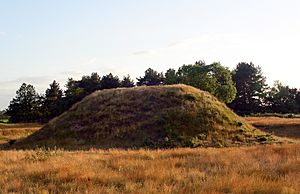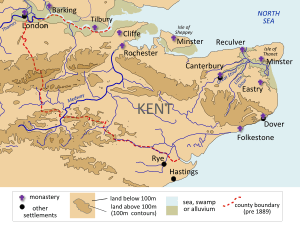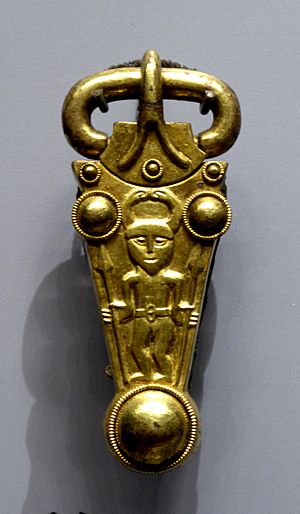Finglesham Anglo-Saxon cemetery facts for kids
| Lua error in Module:Location_map at line 420: attempt to index field 'wikibase' (a nil value). | |
| Established | 6th century CE |
|---|---|
| Dissolved | 8th century CE |
| Location | Finglesham, Kent |
| Type | Anglo-Saxon inhumation cemetery |
The Finglesham Anglo-Saxon cemetery is an ancient burial ground. People used it from the 500s to the 700s CE. It is found near the village of Finglesham in Kent, South East England. This cemetery is a part of the larger history of Anglo-Saxon burials in England.
At Finglesham, people were only buried, not cremated. This is called an inhumation cemetery. Many of the people buried here had special items placed with them. These items are called grave goods. They included things like jewelry, weapons, and everyday tools. Some graves even had small hills built over them, known as tumuli or burial mounds.
This important site was first dug up by archaeologists in 1928–29. This happened because chalk mining was threatening the area. Later, deep plowing also became a problem. So, more digging took place between 1959 and 1967. This work was led by archaeologist Sonia Chadwick Hawkes.
Contents
Where is the Finglesham Cemetery?
The Finglesham Anglo-Saxon cemetery is located about 4.5 kilometers south of Sandwich. It is also 2 kilometers southeast of Eastry in eastern Kent. The cemetery sits on top of a chalk hill. This spot is 30 meters high and offers great views. You can see it from far away.
Close to the cemetery, there is a spring. This spring feeds into a stream. In Anglo-Saxon times, this spring would have been a very important source of fresh water. The ground here is mostly chalk, with some clay.
Archaeologists believe the cemetery served a local community. Even though no settlement has been found, it was likely near the fresh water. The name Finglesham comes from an old English word. It means "the Prince's manor or homestead." No royal burials have been found here. This suggests a Kentish prince might have owned the land but was buried somewhere else.
Understanding the Anglo-Saxon Period
The Anglo-Saxon period began in the 400s CE. During this time, the area that became Kent changed a lot. Before this, it was part of the Roman Empire. After Roman rule ended around 410 CE, many Roman ways of life disappeared. They were replaced by Anglo-Saxon culture.
Later Anglo-Saxon stories say that tribes from northern Europe came to England. These tribes were the Angles, Saxons, and Jutes. But archaeologists have found that Anglo-Saxon and Roman cultures mixed. This mixing is called syncretism.
The name Kent comes from an older Celtic name. At first, it only meant the area east of the River Medway. By the late 500s, it included areas to the west too. The Kingdom of Kent was the first Anglo-Saxon kingdom recorded in history. By the end of the 500s, it was very powerful.
Kent had strong trade links with Francia (modern-day France). The Kentish royal family even married into Francia's royal family. Kentish King Æthelberht of Kent became Christian in the early 600s. This happened because Augustine of Canterbury came to England. He was sent by Pope Gregory I to spread Christianity. The Finglesham cemetery was used during this important time.
Kent has many ancient burial sites from this period. People started digging up Anglo-Saxon graves in the 1600s. Back then, they were called antiquarians. Over time, their interest grew into more scientific archaeology. Famous archaeologists like Bryan Faussett studied these sites.
What Did the Finglesham Cemetery Look Like?
Archaeologists believe the Finglesham cemetery was used from about 500 CE to 725 CE. Most of the burials are from the 600s. The richest grave goods were found in burials from the early and middle 500s. Similar rich burials have been found at other cemeteries nearby. These include Bifrons, Lyminge, and Dover Buckland.
The cemetery was shaped like a triangle or trapezoid. It was about 70 meters by 80 meters wide. This covers about half a hectare (about 1.2 acres). A track called Whiteway marks the western edge of the cemetery. We don't know how old this track is.

Many graves had circular ditches around them. This means they were once covered by small hills or mounds. These are called barrows or tumuli. Most of these mounds were on the southeastern side of the cemetery. The largest mound, over Grave 204, would have been very noticeable. It might have even been a landmark for people in the area.
Important Discoveries: Grave Goods
The Finglesham Man and the Buckle
One of the most famous finds from Finglesham is a special buckle. It is known as the Finglesham Buckle. This buckle was found in a grave that archaeologists call "The Finglesham Man." This grave was very important. It contained many interesting items that tell us about Anglo-Saxon life.
The Finglesham Buckle is made of bronze and decorated with a unique design. It shows a human figure with animal features. This type of art is common in Anglo-Saxon times. It helps us understand their beliefs and artistic skills.
How Archaeologists Studied the Site
Early Investigations by Stebbing and Whiting
In late 1928, two local archaeologists, William Stebbing and William Whiting, learned about the cemetery. A farmer told them that human bones were found near a chalk pit. They worried that the site would be destroyed by chalk mining.
Stebbing and Whiting quickly raised money for an excavation. They hired workers and dug up 38 graves. They published a report about their findings in 1929. The items they found were shared between them and the local landowner. Some of the finer jewelry was kept by the landowner.
The archaeologists wanted more people to see the finds. So, they put them on display at a museum in Ospringe. Later, the items were moved to Deal Castle and then to Deal Public Library. In 1992, the exhibit closed, and the objects were stored at Dover Museum.
Sonia Hawkes' Major Excavation
In 1956, a young archaeologist named Sonia Chadwick Hawkes became interested in the Finglesham finds. She studied the existing artifacts and wrote a paper about them. Her work was one of the first modern studies of Anglo-Saxon graves in East Kent.
Hawkes visited the site and saw that it was still being damaged. Not only by chalk quarrying but also by deep plowing. She started a large excavation project. This project lasted for 19 weeks between 1959 and 1967. During this time, her team dug up the entire cemetery area. They found 216 graves, including some that Stebbing and Whiting had found earlier.
The grave goods found during Hawkes' excavation stayed with the landowner. However, Hawkes placed many of them in the care of the Ashmolean Museum. Sonia Hawkes continued to study and write about Finglesham for many years. She published several articles about different parts of the cemetery. Her work greatly influenced how other archaeologists studied Anglo-Saxon cemeteries.
Sadly, Sonia Hawkes passed away in 1999 before her full report was published. Later, other archaeologists worked to get her findings published. The complete excavation report finally came out in 2007. This made the important information from Finglesham available to everyone.
Images for kids






